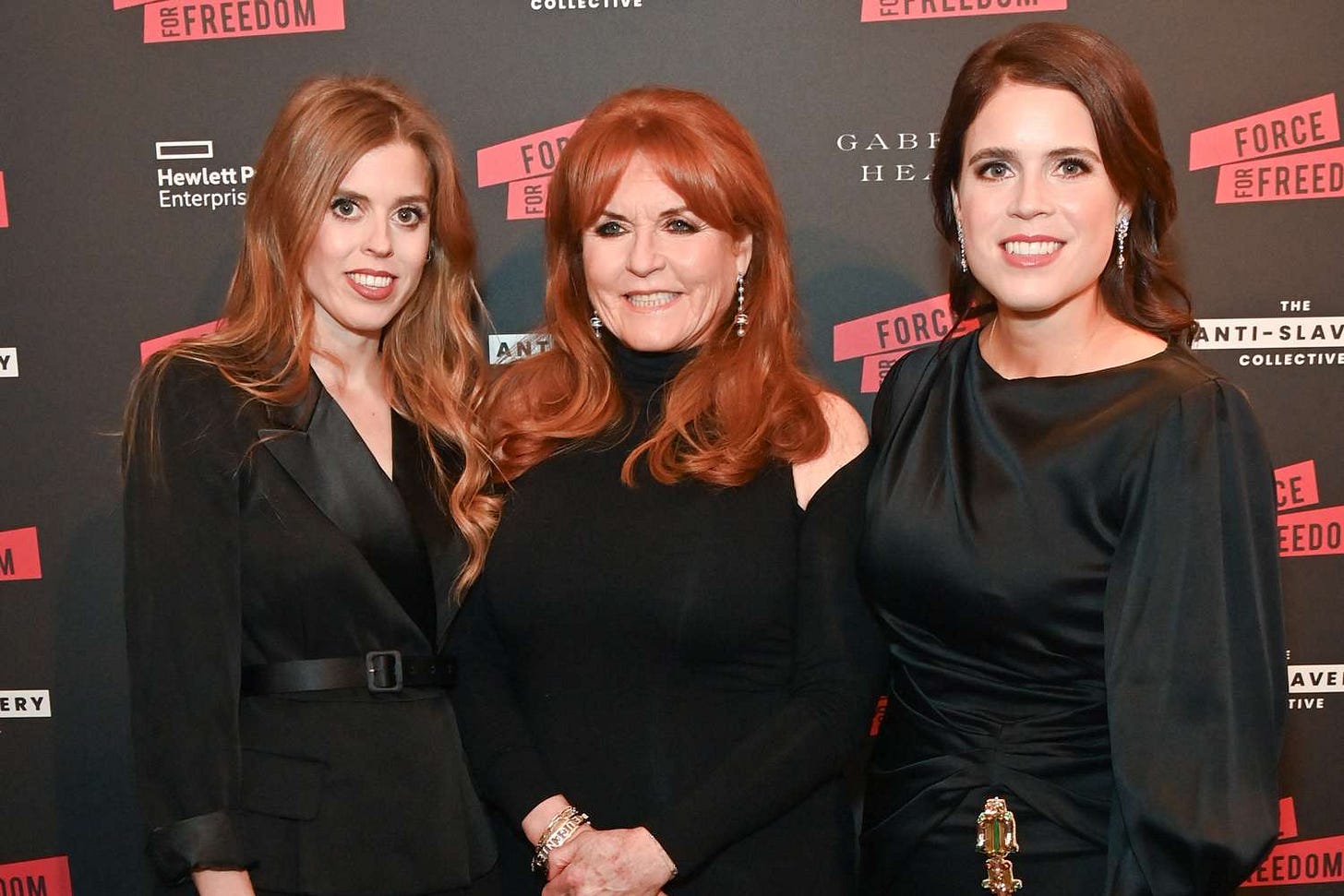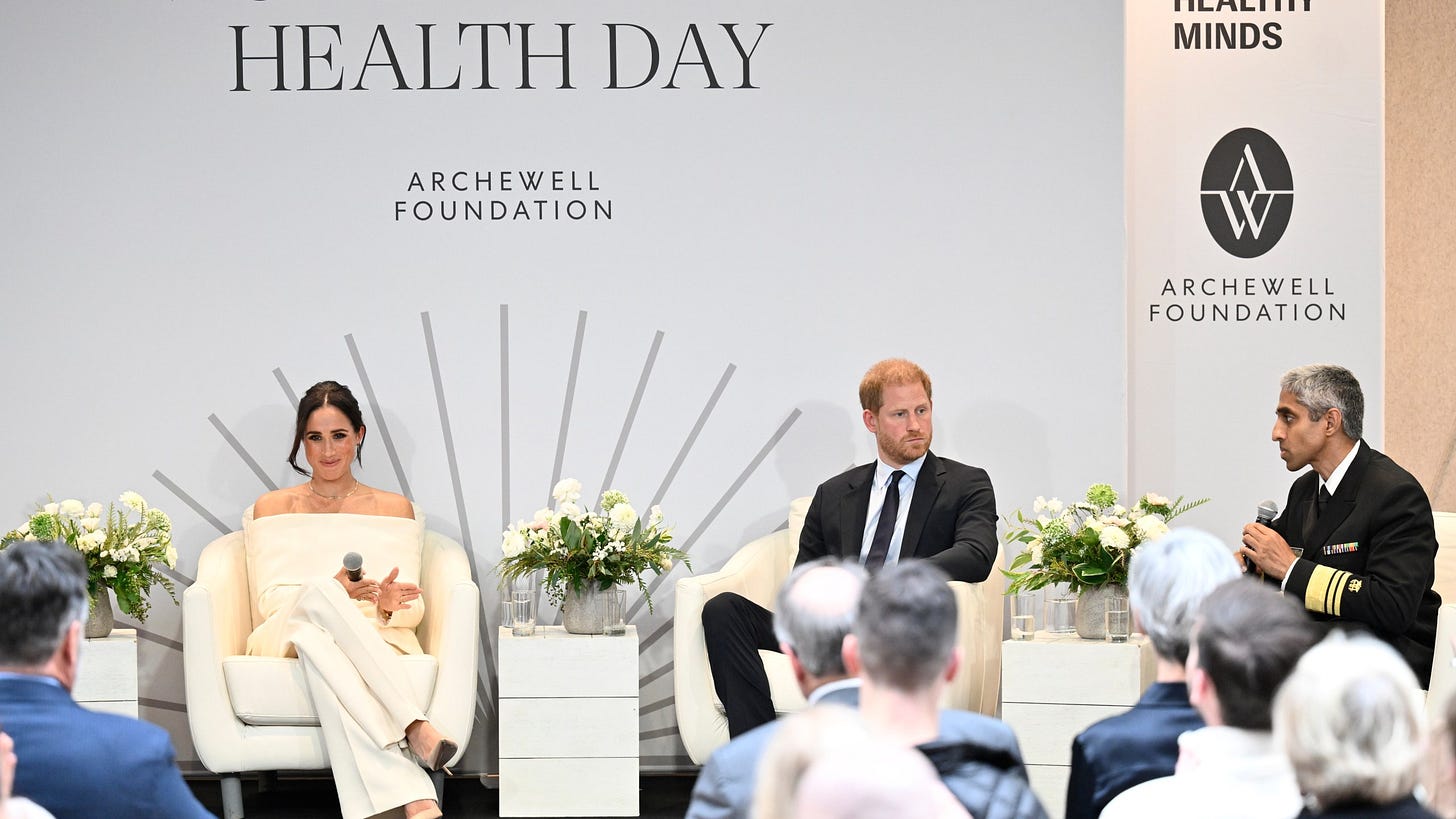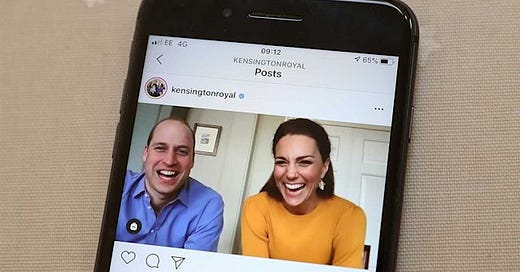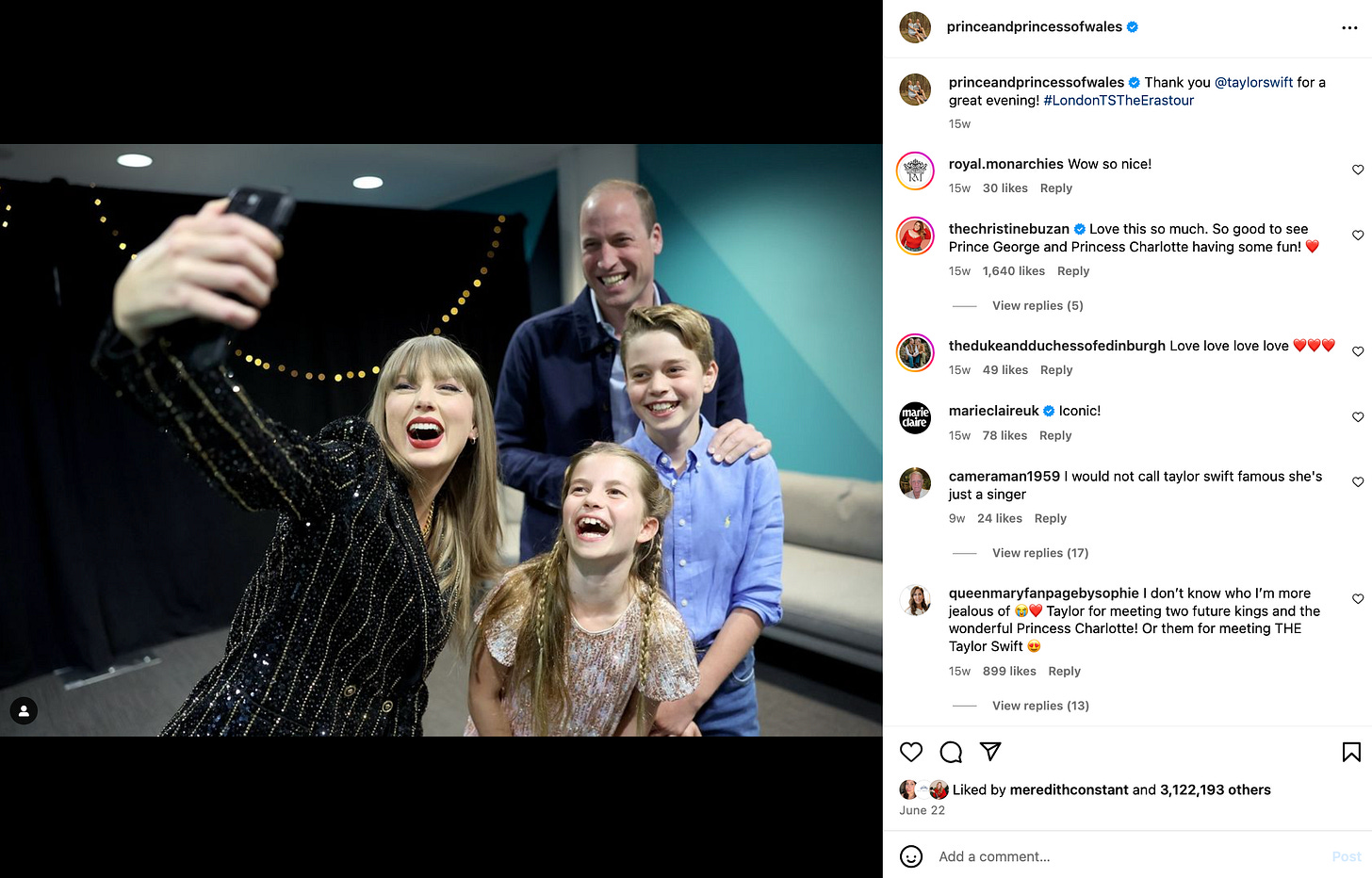The Royals Grapple with Modern Life, One Insta Post at a Time
how social media is blurring the lines between public duty and private identity
It’s no secret that there’s been an interesting shift in recent years in how members of the British Royal Family present themselves, both publicly and privately. (Don’t worry, we’re not talking about that dang video again.) However, this shift is especially noticeable on social media, where the royals are taking advantage of platforms like Instagram and X (formerly Twitter) to reshape how we perceive them—both as representatives of the monarchy, and as individuals.
But what happens when the lines between public duty and personal identity start to blur?
Traditionally, the monarchy operates as a tightly bound institution, with “working” royals serving as public representatives of the Crown and “non-working” royals (at least in theory) having more freedom to live outside of the spotlight. You’d be forgiven for not knowing the difference, as the British monarchy strives to remain relevant in Palace 2.0 (my pet name for the monarchy under King Charles III)).
Take, for instance, the family’s most famous pair: Prince and Princess of Wales. Their social media accounts have begun sharing what feel like more personal moments—yes, family B-roll, but also behind-the-scenes looks at engagements that are wrapped in the fabric of their public roles.
Further complicating things, the desire for a royal-adjacent personal narrative isn’t confined to the “working” royal roster. Non-working family members like Princess Beatrice and Eugenie are also navigating this landscape—albeit with more freedom to shape their individual paths.
Let’s examine both sides of the coin here, and see what we can tease out.
It may be the photo of the summer: Prince William taking his children to meet Taylor Swift and Travis Kelce.
This meeting with two global superstars could have stayed private, but when the snapshot from the meeting was shared on both Swift and the Prince and Princess of Wales' official social media, it served a dual purpose. On one hand, it offered a relatable, human moment that reflects William’s role as a father who wants to give his children fun experiences. On the other, it strategically tapped into the immense popularity of Swift and Kelce, allowing the royal family to connect with broader, often younger audiences who may not be as engaged with traditional royal duties.
Posting this moment on an official Palace account was the first instance of Will and Kate subtly blending the personal with the institutional, offering a modern, approachable view of capital-R royal life. The post also signaled that while they are steeped in tradition, Will, Kate, and their family are still very much part of the modern world.
These so-called "personal" moments still come with an official stamp, curated and managed within the context of official royal work. These posts aren’t just casual updates; they are part of an evolving narrative of what it means to be a royal in the 21st century, where the line between the personal and the official is increasingly blurred.
Now consider non-working royals, like Princesses Beatrice and Eugenie, who don’t receive taxpayer funding and have more freedom to pursue their own careers and passions. While they are not senior members of the family with official roles, they still enjoy proximity to the palace and the institution it represents. Their presence at key family events—from Trooping the Colour to the Coronation—allows them to maintain a visible connection to the monarchy. It’s even been rumored that Beatrice retains an apartment at Clarence House.
Nevertheless, these ties do not extend to a formal public role, leaving such “non-working” members of the family more freedom to pursue personal endeavors like their professional careers and philanthropic activities.
Eugenie, for example, is active on her personal Instagram, where she regularly posts about her charitable work and highlights quasi-royal-engagement style events with organizations close to her heart. But this is on her personal account—separate from the institution of the monarchy, but still undeniably part of its world.
This duality points to a desire among the modern royals to remain part of the monarchy’s world…while also shaping individual paths outside the firm. And it’s fascinating (to me, anyway) to see this dance play out in real-time, often right before our eyes on Instagram.
The Public Duty of Working Royals
When it comes to the working royals—those who are considered full-time representatives of the Crown—their identities are, in many ways, inseparable from their roles. William and Kate, for instance, may try to add a personal touch to their social media feeds, but their lives are still guided by the responsibilities they bear as future monarchs. Their lives are characterized by a sense of public duty that often supersedes personal expression. They must walk a delicate tightrope: being relatable enough to maintain public support, while also upholding the dignity and mystique of the monarchy. Every personal post about their children or an off-duty visit to the ballet serves a broader narrative that reaffirms their place in the royal machine.
For Will and Kate, the pursuit of individuality seems to be about balancing tradition with modernity, choosing carefully when and how they engage with the public eye. And sharing personal moments, no matter how staged, allows the Waleses to tap into the human side of royal life that has often been, in past eras, lost amid ceremonial duties and traditional constraints.
This approach isn’t just a PR strategy; it’s essential for maintaining relevance in a rapidly changing world. The modern monarchy is not just a symbol of continuity but also an evolving institution, attempting to adapt to new expectations. So what about the flip side: the non-working royals who move freely about the world?
The Quiet Influence of Non-Working Royals
Princess Eugenie and her sister, Princess Beatrice, often find themselves at an interesting crossroads. They are undoubtedly part of the royal family, and regularly interface with the public, but without the same level of public funding or official responsibility as their cousins. This doesn’t mean they are completely disconnected from royal life or its influence, though; Eugenie’s Instagram remains a prime example of how social media can be leveraged to showcase a royal’s work with various charities and causes.

There seems to be an unspoken understanding here: even though Eugenie isn’t a working royal in the traditional sense, she is still closely associated with the institution. This blurring of personal and “royal-adjacent” engagements allows her to maintain a public profile tied to the royal institution without the formal obligations of a working role. Her social media posts aren’t framed as official royal duties, but they function in much the same way. They uphold the values of the monarchy, promote charitable causes, and remind the public that the royal family is more than just those who take on full-time roles.
Isn’t it interesting that a private individual can enjoy a curated public identity alongside the prestige of royal connections? This is almost exactly what Harry and Meghan sought when they stepped back from royal duties in 2020.
In another universe, they may have been free to pursue careers and passions outside of the rigid confines of royal protocol—like Beatrice and Eugenie. They also recognized that their titles and status meant they would always be viewed as extensions of the Crown, and wanted to do right by that association. Now, four years down the line, I can’t help but think that the Palace has come to terms with the fact that personal passions can’t be fully separated from the royal brand. It’s almost like Harry and Meghan realized that a reckoning with this tension needed to happen. Weird!

One of the core reasons behind the Duke and Duchess of Sussex’s choice to step back from royal duties was their frustration with the lack of a clear boundary between their public roles and private lives. Meghan, in particular, spoke about feeling like her every move was scrutinized, with little autonomy over how her image was managed. The inability to curate their personal narrative and shield intimate aspects of their lives from constant media attention became a prominent concern for the Sussexes, ultimately leading to their decision to leave the institution and seek greater control in their personal and professional lives.
In contrast, Will and Kate now appear able to strike that balance just fine, by selectively sharing glimpses of their private lives while maintaining their core roles as senior working royals. Firmly controlling the narrative around these personal moments, they still retain their connection to royal duty. Does this tell us that lessons were learned from Harry and Meghan’s exit? Because there’s no question that Will and Kate now embrace a more flexible model where private and public roles can coexist in a way that feels sustainable. They’ve grabbed hold of the ability to carefully curate what is shared, and when, giving them the autonomy that Harry and Meghan craved, but within the framework of the monarchy. There might have been a “middle path” all along, one where personal concerns could be considered without fully stepping away from the royal institution.
The Desire for Individuality
Whether we’re talking about “working” or “non-working” royals, there’s a common thread running through both groups: the desire to maintain a sense of identity, while still honoring their unique position within the institution. And by sharing these engagements themselves, people like Eugeine, Beatrice, William, and Kate all retain control over how they present their identities to the public. Will and Kate, though fully entrenched in royal duty, use their social media presence to craft a more personal image, while Eugenie and Beatrice, though not working royals, still uphold the monarchy’s values through their charity work and public-facing platforms.
By sharing both public and private content directly on platforms like Instagram, Will and Kate now bypass traditional media gatekeepers and speak directly to their audience, allowing them to curate their own image, and ensure that the moments they share are framed exactly as they want, without the risk of misinterpretation or sensationalism. (Again, exactly what Meghan and Harry expressed a desire to do).
It’s a delicate dance, one that reflects the evolving nature of the royal family in the modern world. The desire to be seen as individuals—to pursue personal passions, to raise families, to engage with causes they care about—exists alongside their roles as members of one of the most famous families in the world.
In the end, this balancing act speaks to a deeper truth about the British royal family today: they are all navigating a world where the personal and the institutional are more intertwined than ever before. We’re seeing a more modern, controlled form of engagement from Kensington Palace, in particular, these days—one which offers Will and Kate, in particular, both agency and personal boundaries. It also represents a conscious effort to modernize the monarchy's communication strategies, adapting to a social media-driven era where direct connection and identity are often more powerful than third-party reporting, press releases, and town criers.
Royal social media feeds—personal and official alike—offer a window into this new reality, where being a royal isn’t just about fulfilling one’s duty, but also about crafting an individual legacy within the confines of an ancient institution.











In my opinion, Will and Kate are following in Harry and Meghan’s footsteps without experiencing similar outrage from the public. Let’s not forget that Harry and Meghan announced the birth of their son directly on instagram and were crucified for this by traditionalists. They used instagram once again to announce their desire to step back from royal duties, and once again they were brutally crucified, not just for their intention, but for bypassing traditional media outlets.
What do you mean, "just fine" about Workshy Willie and the world's laziest professional patient? I've had cancer, so forgive me, but I can say that, as Kate has not said one verifiable word about her long absence and alleged treatment - image the good she could have done for all of us cancer survivors had she had the bother to speak the truth about detection and her actual treatment. Nor has she bothered to thank the medical staff who would have been tending to her for all these months. (If Charles can be out there working during his treatment, at his age, why couldn't Kate?) So.... how does she actually contribute to the Royals? Have you forgotten all the bogus images she and her equally lazy hubby posted - what a con! Do you honestly think that's "just fine?" As for H&M, I daresay a woman of your intelligence and wonderful writing talent knows full well the impact of the ugliest racism on Meghan and the UK media's collusion with Kensington Palace to bring her down. Thank goodness she and Harry got out - they've done more good for the world in a scant few years than W&K have done in their lifetimes.